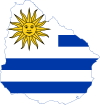Paraguayan War
The Paraguayan War, also known as the War of the Triple Alliance[upper-alpha 1] was a South American war fought from 1864 to 1870, between Paraguay and the Triple Alliance of Argentina, the Empire of Brazil, and Uruguay. It was the deadliest and bloodiest inter-state war in Latin America's history.[4] It particularly devastated Paraguay, which suffered catastrophic losses in population (the numbers are disputed and the true mortality rate may never be known), and it was forced to cede territory in dispute with Argentina and Brazil.
The war began in late 1864, as a result of a conflict between Paraguay and Brazil caused by the Uruguayan War. Argentina and Uruguay entered the war against Paraguay in 1865, and it then became known as the "War of the Triple Alliance".
The war ended with the total defeat of Paraguay. After it lost in conventional warfare, Paraguay conducted a drawn-out guerrilla resistance, a disastrous strategy that resulted in the further destruction of the Paraguayan military and much of the civilian population through battle casualties, hunger and disease. The guerrilla war lasted 14 months until President Francisco Solano López was killed in action by Brazilian forces in the Battle of Cerro Corá on 1 March 1870. Argentine and Brazilian troops occupied Paraguay until 1876. Estimates of total Paraguayan losses range from 21,000 to 200,000 people. It took decades for Paraguay to recover from the chaos and demographic losses.
Background
Territorial disputes
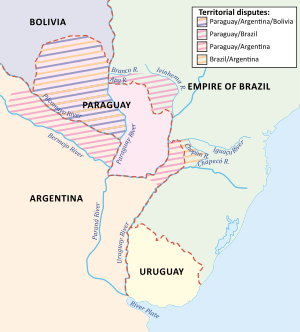
Since their independence from Portugal and Spain in the early 19th century, the Empire of Brazil and the Spanish-American countries of South America were troubled by territorial disputes. All nations in the region had lingering boundary conflicts with multiple neighbors. Most had overlapping claims to the same territories. These issues were questions inherited from their former metropoles, which, despite several attempts, were never able to resolve them satisfactorily. Signed by Portugal and Spain in 1494, the Treaty of Tordesillas proved ineffective in the following centuries as both colonial powers expanded their frontiers in South America and elsewhere. The outdated boundary lines did not represent actual occupation of lands by the Portuguese and Spanish.
By the early 1700s, the Treaty of Tordesillas was deemed all but useless and it was clear to both parties that a newer one had to be drawn based on realistic and feasible boundaries. In 1750, the Treaty of Madrid separated the Portuguese and Spanish areas of South America in lines that mostly corresponded to present-day boundaries. Neither Portugal nor Spain were satisfied with the results, and new treaties were signed in the following decades that either established new territorial lines or repealed them. The final accord signed by both powers, the Treaty of Badajoz (1801), reaffirmed the validity of the previous Treaty of San Ildefonso (1777), which had derived from the older Treaty of Madrid.
The territorial disputes became worse when the Viceroyalty of the Río de la Plata collapsed in the early 1810s, leading to the rise of Argentina, Paraguay, Bolivia and Uruguay. Historian Pelham Horton Box writes: "Imperial Spain bequeathed to the emancipated Spanish-American nations not only her own frontier disputes with Portuguese Brazil, but problems which had not disturbed her, relating to the exact boundaries of her own viceroyalties, captaincies general, audiencias and provinces."[5] Once separated, Argentina, Paraguay and Bolivia quarreled over lands that were mostly uncharted and unknown. They were either scarcely populated or settled by indigenous tribes that answered to no parties.[6][7] In the case of Paraguay with her neighbor Brazil, the problem was to define whether the Apa or Branco rivers should represent their actual boundary, a persistent issue that had vexed and confused Spain and Portugal in the late 18th century. The region between both rivers was populated only by some indigenous tribes that roamed the area attacking nearer Brazilian and Paraguayan settlements.[8][9]
Political situation before the war
There are several theories regarding the origins of the war. The traditional view emphasizes the policies of Paraguayan president Francisco Solano López, who used the Uruguayan War as a pretext to gain control of the Platine basin. This caused a response from the regional hegemons Brazil and Argentina, who exercised influence over the much smaller republics of Uruguay and Paraguay.
The war has also been attributed to the after-effects of colonialism in South America, with border conflicts between the new states, the struggle for power among neighboring nations over the strategic Río de la Plata region, Brazilian and Argentine meddling in internal Uruguayan politics (which had already caused the Platine War), and Solano López's efforts to help his allies in Uruguay (previously defeated by the Brazilians), as well as his presumed expansionist ambitions.[10]
Before the war Paraguay had experienced rapid economic and military growth as a result of its protectionist policies that had boosted the local industry (much to the detriment of British imports). A strong military was developed because Paraguay's larger neighbors Argentina and Brazil had territorial claims against it and wanted to dominate it politically much like they did in Uruguay. Paraguay had recurring boundary disputes and tariff issues with Argentina and Brazil for many years during the rule of Carlos Antonio López.
Regional tension
In the time since Brazil and Argentina had become independent, their struggle for hegemony in the Río de la Plata region had profoundly marked the diplomatic and political relations among the countries of the region.[11]
Brazil was the first country to recognize the independence of Paraguay, in 1844. At this time Argentina still considered it a breakaway province. While Argentina was ruled by Juan Manuel Rosas (1829–1852), a common enemy of both Brazil and Paraguay, Brazil contributed to the improvement of the fortifications and development of the Paraguayan army, sending officials and technical help to Asunción.
As no roads linked the inland province of Mato Grosso to Rio de Janeiro, Brazilian ships needed to travel through Paraguayan territory, going up the Paraguay River to arrive at Cuiabá. However, Brazil had difficulty obtaining permission from the government in Asunción to freely use the Paraguay River for its shipping needs.
Uruguayan prelude
Brazil had carried out three political and military interventions in the politically unstable Uruguay: in 1851 against Manuel Oribe in order to fight Argentine influence in the country and to end the Great Siege of Montevideo; in 1855, at the request of the Uruguayan government and Venancio Flores, leader of the Colorado Party, which was traditionally supported by the Brazilian empire; and in 1864, against Atanasio Aguirre. This last intervention would lead to the Paraguayan War.
On 19 April 1863, Uruguayan General Venancio Flores, who was then an officer in the Argentine army and the leader of the Colorado Party of Uruguay,[12] invaded his country, starting the Cruzada Libertadora, with open support of Argentina which supplied rebels with arms, ammunition and 2,000 men.[13] Flores wanted to overthrow the Blanco Party government of President Bernardo Berro,[14]:24 which was allied with Paraguay.[14]:24
Paraguayan President López sent a note to the Argentine government on 6 September 1863, asking for an explanation, but Buenos Aires denied any involvement in Uruguay.[14]:24 From that moment, mandatory military service was introduced in Paraguay; in February 1864, an additional 64,000 men were drafted into the army.[14]:24
One year after the beginning of the Cruzada Libertadora, in April 1864, Brazilian minister José Antônio Saraiva arrived in Uruguayan waters with the Imperial Fleet, to demand payment for damages caused to gaucho farmers in border conflicts with Uruguayan farmers. Uruguayan President Atanasio Aguirre, from the Blanco Party, rejected the Brazilian demands, presented his own demands and asked Paraguay for help.[15] To settle the growing crisis, Solano López offered himself as mediator of the Uruguayan crisis, as he was a political and diplomatic ally of the Uruguayan Blancos, but the offer was turned down by Brazil.[16]
Brazilian soldiers on the northern borders of Uruguay started to provide help to Flores' troops and harassed Uruguayan officers, while the Imperial Fleet pressed hard on Montevideo.[17] During the months of June–August 1864 a Cooperation Treaty was signed between Brazil and Argentina at Buenos Aires, for mutual assistance in the Plate Basin Crisis. [18]
Brazilian Minister Saraiva sent an ultimatum to the Uruguayan government on 4 August 1864: either comply with the Brazilian demands, or the Brazilian army would retaliate.[19] The Paraguayan government was informed of all this and sent to Brazil a message, which stated in part:
The government of the Republic of Paraguay will consider any occupation of the Oriental territory [i.e. Uruguay] as an attempt against the equilibrium of the states of the Plate which interests the Republic of Paraguay as a guarantee for its security, peace, and prosperity; and that it protests in the most solemn manner against the act, freeing itself for the future of every responsibility that may arise from the present declaration.
— José Berges, Paraguayan chancellor, to Vianna de Lima, Brazilian minister to the Paraguayan government. August 30, 1864.[20]
The Brazilian government, probably believing that the Paraguayan threat would be only diplomatic, answered on 1 September, stating that "they will never abandon the duty of protecting the lives and interests of Brazilian subjects". But in its answer two days later Paraguayan government insisted that "if Brazil takes the measures protested against in the note of August 30th, 1864, Paraguay will be under the painful necessity of making its protest effective."[21]
On 12 October, despite the Paraguayan notes and ultimatums, Brazilian troops under the command of Gen. João Propício Mena Barreto invaded Uruguay,[14]:24 thus marking the beginning of the hostilities.[1] Paraguayan military actions against Brazil began on 12 November, when the Paraguayan ship Tacuarí captured the Brazilian ship Marquês de Olinda, which had sailed up the Paraguay River to the province of Mato Grosso,[22] with the Province's newly appointed President on board. Paraguay would officially declare war on Brazil only on 13 December 1864,[23] on the eve of the Paraguayan invasion on the Brazilian province of Mato Grosso.
The conflict between Brazil and Uruguay was settled in February 1865. News of the war's end was brought by Pereira Pinto and met with joy in Rio de Janeiro. Brazilian Emperor Dom Pedro II found himself waylaid by a crowd of thousands in the streets amid acclamations.[24][25] However, public opinion quickly changed for the worse when newspapers began running stories painting the convention of 20 February as harmful to Brazilian interests, for which the cabinet was blamed. The newly raised Viscount of Tamandaré and Mena Barreto (now Baron of São Gabriel) had supported the peace accord.[26] Tamandaré changed his mind soon afterward and played along with the allegations. A member of the opposition party, José Paranhos, Viscount of Rio Branco, was used as a scapegoat by the Emperor and the government and was recalled in disgrace to the imperial capital.[27] The accusation that the convention had failed to meet Brazilian interests proved to be unfounded. Not only had Paranhos managed to settle all Brazilian claims, but by preventing the death of thousands, he gained a willing and grateful Uruguayan ally instead of a dubious and resentful one, which provided Brazil with an important base of operations during the acute clash with Paraguay that shortly ensued.[28]
Opposing forces
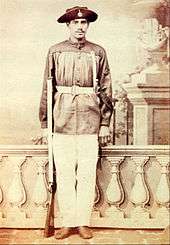
Paraguay
According to some historians, Paraguay began the war with over 60,000 trained men—38,000 of whom were already under arms—400 cannons, a naval squadron of 23 steamboats (vapores) and five river-navigating ships (among them the Tacuarí gunboat).[29]
Communications in the Río de la Plata basin were maintained solely by river as very few roads existed. Whoever controlled the rivers would win the war, so Paraguay had built fortifications on the banks of the lower end of the Paraguay River.[14]:28–30
However, recent studies suggest many problems. Although the Paraguayan army had between 70,000 and 100,000 men at the beginning of the conflict, they were badly equipped. Most infantry armaments consisted of inaccurate smooth-bore muskets and carbines, slow to reload and short-ranged. The artillery was similarly poor. Military officers had no training or experience, and there was no command system, as all decisions were made personally by López. Food, ammunition and armaments were scarce, with logistics and hospital care deficient or nonexistent.[30] The nation of about 450,000 people could not stand against the Triple Alliance of 11 million people.
Brazil and its allies
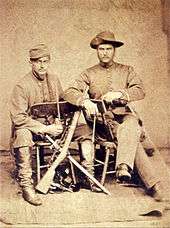
At the beginning of the war the military forces of Brazil, Argentina and Uruguay were far smaller than Paraguay's. Argentina had approximately 8,500 regular troops and a naval squadron of four vapores and one goleta. Uruguay entered the war with fewer than 2,000 men and no navy. Many of Brazil's 16,000 troops were located in its southern garrisons [31] The Brazilian advantage, though, was in its navy, comprising 45 ships with 239 cannons and about 4,000 well-trained crew. A great part of the squadron was already in the Rio de la Plata basin, where it had acted under the Marquis of Tamandaré in the intervention against Aguirre government.
Brazil, however, was unprepared to fight a war. Its army was disorganized. The troops it used in Uruguay were mostly armed contingents of gauchos and National Guard. While some Brazilian accounts of the war described their infantry as volunteers (Voluntários da Pátria), other Argentinian revisionist and Paraguayan accounts disparaged the Brazilian infantry as mainly recruited from slaves and the landless (largely black) underclass, who were promised free land for enlisting.[32] The cavalry was formed from the National Guard of Rio Grande do Sul.
Ultimately, a total of about 146,000 Brazilians fought in the war from 1864 to 1870, consisting of the 10,025 army soldiers stationed in Uruguayan territory in 1864, 2,047 that were in the province of Mato Grosso, 55,985 Fatherland Volunteers, 60,009 National Guardsmen, 8,570 ex-slaves who had been freed to be sent to war, and 9,177 navy personnel. Another 18,000 National Guard troops stayed behind to defend Brazilian territory.[33]
The war begins
Paraguayan offensive in Mato Grosso

Paraguay took the initiative during the first phase of the war, launching the Mato Grosso Campaign by invading the Brazilian province of Mato Grosso on 14 December 1864,[14]:25 followed by an invasion of the Rio Grande do Sul province in the south in early 1865 and the Argentine Corrientes Province.
Two separate Paraguayan forces invaded Mato Grosso simultaneously. An expedition of 3,248 troops, commanded by Col. Vicente Barrios, was transported by a naval squadron under the command of Capitán de Fragata Pedro Ignacio Meza up the Paraguay River to the town of Concepcion.[14]:25 There they attacked the Nova Coimbra fort on 27 December 1864.[14]:26 The Brazilian garrison of 154 men resisted for three days, under the command of Lt. Col. Hermenegildo de Albuquerque Porto Carrero (later Baron of Fort Coimbra). When their munitions were exhausted, the defenders abandoned the fort and withdrew up the river towards Corumbá on board the gunship Anhambaí.[14]:26 After occupying the fort, the Paraguayans advanced further north, taking the cities of Albuquerque, Tage and Corumbá in January 1865.[14]:26
Solano López then sent a detachment to attack the military frontier post of Dourados. On 29 December 1864, this detachment, led by Maj. Martín Urbieta, encountered tough resistance from Lt. Antonio João Ribeiro and his 16 men, who were all eventually killed. The Paraguayans continued to Nioaque and Miranda, defeating the troops of Col. José Dias da Silva. Coxim was taken in April 1865. The second Paraguayan column, formed from some of the 4,650 men led by Col. Francisco Isidoro Resquín at Concepcion, penetrated into Mato Grosso with 1500 troops.[14]:26
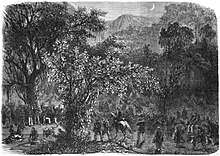
Despite these victories, the Paraguayan forces did not continue to Cuiabá, the capital of the province, where Augusto Leverger had fortified the camp of Melgaço. Their main objective was the capture of the gold and diamond mines, disrupting the flow of these materials into Brazil until 1869.[14]:27
Brazil sent an expedition to fight the invaders in Mato Grosso. A column of 2,780 men led by Col. Manuel Pedro Drago left Uberaba in Minas Gerais in April 1865 and arrived at Coxim in December after a difficult march of more than 2,000 kilometres (1,200 mi) through four provinces. However, Paraguay had already abandoned Coxim by December. Drago arrived at Miranda in September 1866, and Paraguayans had left once again. Col. Carlos de Morais Camisão assumed command of the column in January 1867—now with only 1,680 men—and decided to invade Paraguayan territory, which he penetrated as far as Laguna [34] where Paraguayan cavalry forced the expedition to retreat.
Despite the efforts of Camisão's troops and the resistance in the region, which succeeded in liberating Corumbá in June 1867, a large portion of Mato Grosso remained under Paraguayan control. The Brazilians withdrew from the area in April 1868, moving their troops to the main theatre of operations, in the south of Paraguay.
Paraguayan invasion of Corrientes and Rio Grande do Sul
_pour_l'arm%C3%A9e_d'op%C3%A9ration._-_D'apr%C3%A8s_les_croquis_envoy%C3%A9s_par_M._Paranhos_Junior.jpg)
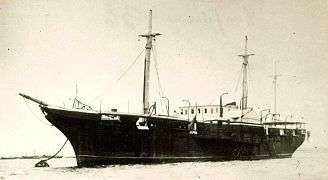
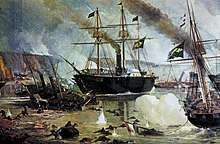
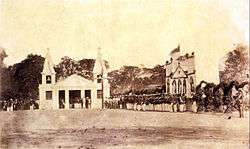
When the war first broke out between Paraguay and Brazil, Argentina had stayed neutral. Solano López doubted Argentina's neutrality, because it gave Brazilian ships permission to navigate in the Argentine rivers of the Plate region, despite Paraguay being at war with Brazil.
The invasion of Corrientes and Rio Grande do Sul provinces was the second phase of the Paraguayan offensive. In order to support the Uruguayan Blancos, the Paraguayans had to travel across Argentine territory. In January 1865, Solano López asked Argentina's permission for an army of 20,000 men (led by Gen. Wenceslao Robles) to travel through the province of Corrientes.[14]:29–30 Argentine President Bartolomé Mitre refused Paraguay's request and a similar one from Brazil.[14]:29
After this refusal Paraguayan Congress gathered at an emergency meeting on 5 March 1865. After several days of discussions, on 23 March the Congress decided to declare war on Argentina for its policies, hostile to Paraguay and favourable to Brazil, and then they conferred to Francisco Solano López Carrillo the rank of Field Marshal of the Republic of Paraguay. The declaration of war was sent on 29 March 1865 to Buenos Aires.[35]
Following the invasion of the Corrientes Province by Paraguay on 13 April 1865, a great uproar stirred in Buenos Aires as the public learned of Paraguay's declaration of war. President Bartolomé Mitre made a famous speech to the crowds on 4 May 1865:
...My fellow countrymen, I promise you: in three days we shall be at the barracks. In three weeks, at the frontiers. And in three months in Asunción![36]
The same day Argentina declared war on Paraguay,[14]:30–31 but days before that, on 1 May 1865, Brazil, Argentina, and Uruguay had signed the secret Treaty of the Triple Alliance in Buenos Aires. They named Bartolomé Mitre, president of Argentina, as supreme commander of the allied forces.[37] The signatories of the treaty were Rufino de Elizalde (Argentina), Octaviano de Almeida (Brazil) and Carlos de Castro (Uruguay).
The Treaty states that Paraguay is to be blamed on all the consequences of the conflict and has to pay all the debt of war, Paraguay has to remain without any fortress and military force. Large portions of Paraguayan territories were to be taken by Argentina and Brazil at the end of the conflict, and the independence of Paraguay was supposed to be respected only for five years. The Treaty sparked international outrage and voices favourable to Paraguay.[38]
On 13 April 1865, a Paraguayan squadron sailed down the Paraná River and attacked two Argentine ships in the port of Corrientes. Immediately Gen. Robles' troops took the city with 3,000 men, and a cavalry force of 800 arrived the same day. Leaving a force of 1,500 men in the city, Robles advanced southwards along the eastern bank.[14]:30
Along with Robles' troops, a force of 12,000 soldiers under Col. Antonio de la Cruz Estigarriba crossed the Argentine border south of Encarnación in May 1865, driving for Rio Grande do Sul. They traveled down Uruguay River and took the town of São Borja on 12 June. Uruguaiana, to the south, was taken on 6 August with little resistance.
By invading Corrientes, Solano López had hoped to gain the support of the powerful Argentine caudillo Justo José de Urquiza, governor of the provinces of Corrientes and Entre Ríos, who was known to be the chief federalist hostile to Mitre and the central government in Buenos Aires.[37] However, Urquiza gave his full support to an Argentine offensive.[14]:31 The forces advanced approximately 200 kilometres (120 mi) south before ultimately ending the offensive in failure.
On 11 June 1865, the naval Battle of Riachuelo the Brazilian fleet commanded by Admiral Francisco Manoel Barroso da Silva destroyed the powerful Paraguayan navy and prevented the Paraguayans from permanently occupying Argentine territory. For all practical purposes, this battle decided the outcome of the war in favor of the Triple Alliance; from that point onward, it controlled the waters of the Río de la Plata basin up to the entrance to Paraguay.[39]
A separate Paraguayan division of 3,200 men that continued towards Uruguay under the command of Maj. Pedro Duarte, was defeated by Allied troops under Venancio Flores in the bloody Battle of Yatay on the banks of the Uruguay River near Paso de los Libres.
Siege of Uruguaiana
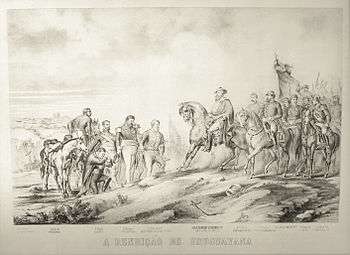
While Solano López ordered the retreat of the forces that had occupied Corrientes, the Paraguayan troops that invaded São Borja advanced, taking Itaqui and Uruguaiana. The situation in Rio Grande do Sul was chaotic, and the local Brazilian military commanders were incapable of mounting effective resistance to the Paraguayans.[40]
The baron of Porto Alegre set out for Uruguaiana, a small town in the province's west, where the Paraguayan army was besieged by a combined force of Brazilian, Argentine and Uruguayan units.[41] Porto Alegre assumed the command of the Brazilian army in Uruguaiana on 21 August 1865.[42] On 18 September, the Paraguayan garrison surrendered without further bloodshed.[43]
Allied counterattack
Invasion of Paraguay
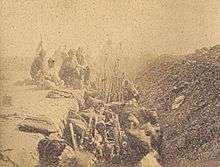
By late 1864, Paraguay had scored a series of victories in the war; on 11 June 1865, however, its naval defeat by Brazil on the Paraná River began to turn the tide. The naval battle of the Riachuelo was a key point in the Paraguayan War, marking the beginning of the offensive of the Allies.
In subsequent months the Paraguayans were driven out of the cities of Corrientes and San Cosme, the only Argentine territory still in Paraguayan possession.
By the end of 1865, the Triple Alliance was on the offensive. Its armies numbered 42,000 infantry and 15,000 cavalry as they invaded Paraguay in April.[14]:51–52 The Paraguayans scored small victories against major forces in the battles of Corrales and Itati, but that couldn't stop the invasion.[44]
On 16 April 1866 the Allied Armies invaded Paraguayan Mainland by crossing the Paraná River.[45] López launched counter-attacks, but they were repelled by Gen. Osorio, who took victories in the battles of Itapirú and Isla Cabrita. Yet, the Allied advance was checked in the first major battle of the war, at Estero Bellaco, on 2 May 1866.[46]
López, believing that he could deal a fatal blow to the Allies, launched a major offensive with 25,000 men against 35,000 Allied soldiers at the Battle of Tuyutí on 24 May 1866, the bloodiest battle in Latin-American history.[47] Despite being very close to victory at Tuyuti, López's plan was shattered by the Allied army's fierce resistance, and the decisive action of the Brazilian artillery.[48] Both sides sustained heavy losses: more than 12,000 casualties for Paraguay versus 6,000 for the Allies.[49][50]

By 18 July, the Paraguayans had recovered, defeating forces commanded by Mitre and Flores in the Battle of Sauce and Boquerón, losing more than 2,000 men against the Allied 6,000 casualties.[51] However, Brazilian Gen. Porto Alegre [52] won the Battle of Curuzu, putting the Paraguayans in a desperate situation.[53]

On 12 September 1866, Solano López, after the defeat in the Battle of Curuzu, invited Mitre and Flores to a conference in Yatayty Cora, which resulted in a "heated argument" among both leaders.[14]:62 Lopez had realized that the war was lost and was ready to sign a peace treaty with the Allies.[54] No agreement was reached, though, since Mitre's conditions for signing the treaty were that every article of the secret Treaty of the Triple Alliance was to be carried out, a condition that Solano López refused.[54] Article 6 of the treaty made truce or peace with López nearly impossible, as it stipulated that the war was to continue until the then government ceased to be, which meant the removal of Solano López.
After the conference, the Allies marched into Paraguayan territory, reaching the defensive line of Curupayty. Trusting in their numerical superiority and the possibility of attacking the flank of the defensive line through the Paraguay River by using the Brazilian ships, the Allies made a frontal assault on the defensive line, supported by the flank fire of the battleships.[55] However, the Paraguayans, commanded by Gen. José E. Díaz, stood strong in their positions and set up for a defensive battle, inflicting tremendous damage on the Allied troops: over 8,000 casualties against no more than 250 losses of the Paraguayans.[56] The Battle of Curupayty resulted in an almost catastrophic defeat for the Allied forces, ending their offensive for ten months, until July 1867.[14]:65
The Allied leaders blamed each other for disastrous failure at Curupayty. Gen. Flores had left for Uruguay in September 1866 and was murdered there in 1867. Porto Alegre and Tamandaré found common ground in their distaste for the Brazilian commander of the 1st corps, field marshal Polidoro Jordão, Viscount of Santa Teresa. Gen. Polidoro was ostracized for supporting Mitre and for being a member of the Conservative Party, while Porto Alegre and Tamandaré were Progressives.[57]
Gen. Porto Alegre also blamed Mitre for the tremendous defeat, saying:
"Here is the result of the Brazilian government's lack of confidence in its generals and giving its Armies to foreign generals".[58]
Mitre had a harsh opinion of the Brazilians and said that "Porto Alegre and Tamandaré, who are cousins, and cousins even in lack of judgement have made a family pact to monopolize, in practice, the command of war." He further criticized Porto Alegre: "It is impossible to imagine a greater military nullity than this general, to which it can be added Tamandaré's dominating bad influence over him and the negative spirit of both in relation to the allies, owning to passions and petty interests."[57]
Caxias assumes command
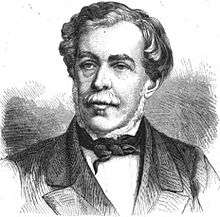
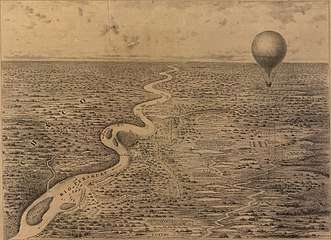
The Brazilian government decided to create a unified command over Brazilian forces operating in Paraguay, and turned to the 63-year-old Caxias as the new leader on 10 October 1866.[59] Osório was sent to organize a 5,000-strong third corps of the Brazilian army in Rio Grande do Sul.[14]:68 Caxias arrived in Itapiru on 17 November 1866.[60] His first measure was to dismiss the Vice-Admiral Joaquim Marques Lisboa (later the Marquis of Tamandaré and also a member of the Progressive League), the government had appointed his fellow Conservative Vice-Admiral Joaquim José Inácio (later the Viscount of Inhaúma) to lead the navy.[60]
The Marquess of Caxias assumed command on 19 November.[61] He had to end the never-ending squabbling and to increase his autonomy from the Brazilian government.[62] With the departure of President Mitre in February 1867, Caxias assumed overall command of the Allied forces.[14]:65 He found the army practically paralyzed and devastated by disease. During this period Caxias trained his soldiers, re-equipped the army with new guns, improved the quality of the officer corps, and upgraded the health corps and overall hygiene of the troops, putting an end to epidemics.[63]
From October 1866 until July 1867, all offensive operations were suspended.[64] Military operations were limited to skirmishes with the Paraguayans and bombarding Curupaity. Solano López took advantage of the disorganization of the enemy to reinforce the Fortress of Humaitá.[14]:70
As the Brazilian army was ready for combat, Caxias sought to encircle Humaitá and force its capitulation by siege. To aid the war effort, Caxias used observation balloons to gather information of the enemy lines.[65] With the 3rd Corps ready for combat, the Allied army started its flanking march around Humaitá on 22 July 1867.[65] The march to outflank the left wing of the Paraguayan fortifications constituted the basis of Caxias' tactics. He wanted to bypass the Paraguayan strongholds, cut the connections between Asunción and Humaitá and finally encircle the Paraguayans. The 2nd corps was stationed in Tuyutí, while the 1st corps and the newly created 3rd corps were used by Caxias to encircle Humaitá.[66] President Mitre returned from Argentina and re-assumed overall command on 1 August.[67]
With the capture on 2 November, by Brazilians troops, of the Paraguayan position of Tahí, at the shores of the river, Humaitá would become isolated from the rest of the country, by land.[68][lower-alpha 1]
Allies gain momentum
Fall of Humaitá
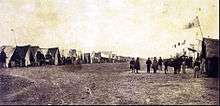
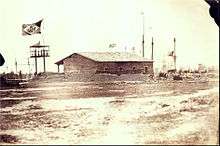
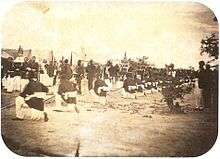
The combined Brazilian–Argentine–Uruguayan army continued advancing north through hostile territory to surround Humaitá. The Allied force advanced to San Solano on the 29th and Tayi on 2 Nov, isolating Humaitá from Asunción.[70] Before dawn on 3 November, Solano López reacted by ordering the attack on the rearguard of the allies in the Second Battle of Tuyutí.[14]:73 The Paraguayans, commanded by Gen. Bernardino Caballero breached the Argentine lines, causing enormous damage to the Allied camp and successfully capturing weapons and supplies, very needed by López for the war effort.[71] Only thanks to intervention of Porto Alegre and his troops, the Allied army recovered.[72] During the Second Battle of Tuyutí, Porto Alegre fought with his saber in hand-to-hand combat and lost two horses.[73] In this battle, the Paraguayans lost over 2,500 men, while the allies had just over 500 casualties.[74]
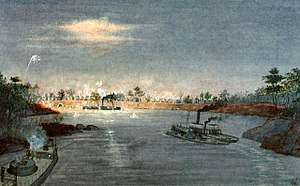
By 1867, Paraguay had lost 60,000 men to battle casualties, injuries, or disease. López conscripted another 60,000 soldiers from slaves and children. Women were entrusted with all support functions. Soldiers went into battle without shoes or uniforms. López enforced the strictest discipline, executing even his two brothers and two brothers-in-law for alleged defeatism.[75]
By December 1867, there were 45,791 Brazilians, 6,000 Argentinians and 500 Uruguayans at the front. After the death of Argentinian Vice-President Marcos Paz, Mitre relinquished his position for the second, and final time on 14 January 1868.[76] Allied representatives in Buenos Aires abolished the position of Allied Commander-in-Chief on 3 October 1868, although the Marquess of Caxias continued to fill the role of Brazilian supreme commander.[77]
On 19 February, Brazilian ironclads successfully made a passage up the Paraguay River under heavy fire, gaining full control of the river and isolating Humaitá from resupply by water.[78] Humaitá fell on 25 July 1868, after a long siege.[14]:86
Fall of Asunción
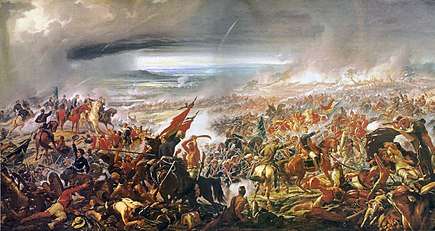
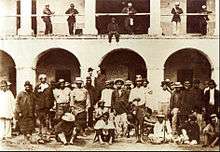
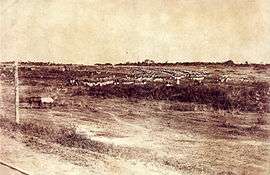

En route to Asunción, the Allied army went 200 kilometres (120 mi) north to Palmas, stopping at the Piquissiri River. There Solano López had concentrated 12,000 Paraguayans in a fortified line that exploited the terrain and supported the forts of Angostura and Itá-Ibaté.
Resigned to frontal combat, Caxias ordered the so-called Piquissiri maneuver. While a squadron attacked Angostura, Caxias made the army cross to the west side of the river. He ordered the construction of a road in the swamps of the Gran Chaco along which the troops advanced to the northeast. At Villeta the army crossed the river again, between Asunción and Piquissiri, behind the fortified Paraguayan line.
Instead of advancing to the capital, already evacuated and bombarded, Caxias went south and attacked the Paraguayans from the rear in December 1868, in an offensive which became known as "Dezembrada".[14]:89–91 First, Caxias advanced being his troops ambushed while crossing the Itororó, where the Paraguayans inflicted severe damage to the Brazilian armies.[79] But days later the Allies destroyed a whole Paraguayan division at the Battle of Avay.[14]:94 Weeks later, Caxias won another decisive victory at the Battle of Lomas Valentinas and captured the last stronghold of the Paraguayan Army in Angostura. On 24 December, Caxias sent a note to Solano López asking for surrender, but Solano López refused and fled to Cerro León.[14]:90–100 Alongside the Paraguayan president was the American Minister-Ambassador, Gen. Martin T. McMahon, who after the war became a fierce defender of López's cause.[80]
Asunción was occupied on 1 January 1869, by Brazilian Gen. João de Souza da Fonseca Costa, father of the future Marshal Hermes da Fonseca. On 5 January, Caxias entered the city with the rest of the army.[14]:99 Most of Caxias army settled in Asuncion, where also 4000 Argentinian and 200 Uruguayan troops soon arrived together with about 800 soldiers and officers of the Paraguayan Legion. By this time, Caxias was ill and tired. On 17 January, he fainted during a mass; he relinquished his command the next day, and the day after that left for Montevideo.[81]
Very soon the city hosted about 30,000 Allied soldiers; for the next few months these looted almost every building, including diplomatic missions of European nations.[81]
Provisional government
With Solano López on the run, the country lacked a government. Pedro II sent his Foreign minister José Paranhos to Asuncion where he arrived on 20 February 1869, and began consultations with the local politicians. Paranhos had to create a provisional government which could sign a peace accord and recognize the border claimed by Brazil between the two nations.[82] According to historian Francisco Doratioto, Paranhos, "the then-greatest Brazilian specialist on Platine affairs", had a "decisive" role in the installation of the Paraguayan provisional government.[83]
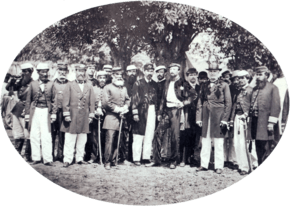
With Paraguay devastated, the power vacuum resulting from Solano López's overthrow was quickly filled by emerging domestic factions which Paranhos had to accommodate. On 31 March, a petition was signed by 335 leading citizens asking Allies for a Provisional government. This was followed by negotiations between the Allied countries, which put aside some of the more controversial points of the Treaty of the Triple Alliance; on 11 June, agreement was reached with Paraguayan opposition figures that a three-man Provisional government would be established. On 22 July, a National Assembly met in the National Theatre and elected Junta Nacional of 21 men which then selected a five-man committee to select three men for the Provisional government. They selected Carlos Loizaga, Juan Francisco Decoud, and Jose Diaz de Bedoya. Decoud was unacceptable to Paranhos, who had him replaced witho Cirilo Antonio Rivarola. The government was finally installed on 15 August, but was just a front for the continued Allied occupation.[81] After the death of Lopez, the Provisional government issued a proclamation on 6 March 1870 in which it promised to support political liberties, to protect commerce and to promote immigration.
The Provisional government did not last. In May 1870, José Díaz de Bedoya resigned; on 31 August 1870, so did Carlos Loizaga. The remaining member, Antonio Rivarola, was then immediately relieved of his duties by the National Assembly, which established a provisional Presidency, to which it elected Facundo Machaín, who assumed his post that same day. However, the next day, 1 September, he was overthrown in a coup that restored Rivarola to power.
End of the war
Campaign of the Hills
.jpg)
The son-in-law of the Emperor Pedro II, Luís Filipe Gastão de Orléans, Count d'Eu, was nominated in 1869 to direct the final phase of the military operations in Paraguay. At the head of 21,000 men, Count d'Eu led the campaign against the Paraguayan resistance, the Campaign of the Mountain Range, which lasted over a year. The most important battles were the battles of Piribebuy and of Acosta Ñu, in which more than 5,000 Paraguayans died.[84]
After a brilliant beginning which included victories over the remnants of Solano López's army, the Count fell into depression and Paranhos became the unacknowledged, de facto commander-in-chief.[85]
Death of Solano López
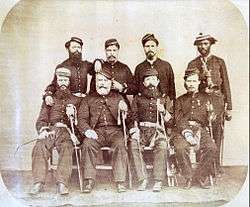
President Solano López organized the resistance in the mountain range northeast of Asunción. At the end of the war, with Paraguay suffering severe shortages of weapons and supplies, Solano López reacted with draconian attempts to keep order, ordering troops to kill any of their colleagues, including officers, who talked of surrender.[86] Paranoia prevailed in the army, and soldiers fought to the bitter end in a resistance movement, resulting in more destruction in the country.[86]
Two detachments were sent in pursuit of Solano López, who was accompanied by 200 men in the forests in the north. On 1 March 1870, the troops of Gen. José Antônio Correia da Câmara surprised the last Paraguayan camp in Cerro Corá. During the ensuing battle, Solano López was wounded and separated from the remainder of his army. Too weak to walk, he was escorted by his aide and a pair of officers, who led him to the banks of the Aquidaban-nigui River. The officers left Solano López and his aide there while they looked for reinforcements. Before they returned, Câmara arrived with a small number of soldiers. Though he offered to permit Solano López to surrender and guaranteed his life, Solano López refused. Shouting "¡Muero con mi patria!" ("I die with my homeland!"), he tried to attack Câmara with his sword. He was quickly killed by Câmara's men, bringing an end to the long conflict in 1870.[87][88]
Casualties of the war

Paraguay suffered massive casualties, and the war's disruption and disease also cost civilian lives. Some historians estimate that the nation lost the majority of its population. The specific numbers are hotly disputed and range widely. A survey of 14 estimates of Paraguay's pre-war population varied between 300,000 and 1,337,000.[89] Later academic work based on demographics produced a wide range of estimates, from a possible low of 21,000 (7% of population) (Reber, 1988) to as high as 69% of the total prewar population (Whigham, Potthast, 1999). Because of the local situation, all casualty figures are a very rough estimate; accurate casualty numbers may never be determined.
After the war, an 1871 census recorded 221,079 inhabitants, of which 106,254 were women, 28,746 were men, and 86,079 were children (with no indication of sex or upper age limit).[90]
The worst reports are that up to 90% of the male population was killed, though this figure is without support.[86] One estimate places total Paraguayan losses — through both war and disease — as high as 1.2 million people, or 90% of its pre-war population,[91] but modern scholarship has shown that this number depends on a population census of 1857 that was a government invention.[92] A different estimate places Paraguayan deaths at approximately 300,000 people out of 500,000 to 525,000 pre-war inhabitants.[93] During the war, many men and boys fled to the countryside and forests.
In the estimation of Vera Blinn Reber, however, "The evidence demonstrates that the Paraguayan population casualties due to the war have been enormously exaggerated".[94]
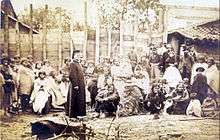
A 1999 study by Thomas Whigham from the University of Georgia and Barbara Potthast (published in the Latin American Research Review under the title "The Paraguayan Rosetta Stone: New Evidence on the Demographics of the Paraguayan War, 1864–1870", and later expanded in the 2002 essay titled "Refining the Numbers: A Response to Reber and Kleinpenning") has a methodology to yield more accurate figures. To establish the population before the war, Whigham used an 1846 census and calculated, based on a population growth rate of 1.7% to 2.5% annually (which was the standard rate at that time), that the immediately pre-war Paraguayan population in 1864 was approximately 420,000–450,000. Based on a census carried out after the war ended, in 1870–1871, Whigham concluded that 150,000–160,000 Paraguayan people had survived, of whom only 28,000 were adult males. In total, 60%–70% of the population died as a result of the war,[95] leaving a woman/man ratio of 4 to 1 (as high as 20 to 1, in the most devastated areas).[95] For academic criticism of the Whigham-Potthast methodology and estimates see the main article Paraguayan War casualties.
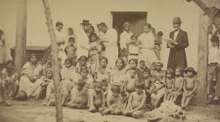
Steven Pinker wrote that, assuming a death rate of over 60% of the Paraguayan population, this war was proportionally one of the most destructive in modern times for any nation state.[96]
Allied losses
Of approximately 123,000 Brazilians who fought in the Paraguayan War, the best estimates are that around 50,000 men died. Uruguay had about 5,600 men under arms (including some foreigners), of whom about 3,100 died. Argentina lost close to 30,000 men.
The high rates of mortality were not all due to combat. As was common before antibiotics were developed, disease caused more deaths than war wounds. Bad food and poor sanitation contributed to disease among troops and civilians. Among the Brazilians, two-thirds of the dead died either in a hospital or on the march. At the beginning of the conflict, most Brazilian soldiers came from the north and northeast regions; the change from a hot to a colder climate, combined with restricted food rations, may have weakened their resistance. Entire battalions of Brazilians were recorded as dying after drinking water from rivers. Therefore, some historians believe cholera, transmitted in the water, was a leading cause of death during the war.
Gender and ethnic aspects
Women in the Paraguayan War
Paraguayan women played a significant role in the Paraguayan War. During the period just before the war began many Paraguayan women were the heads of their households, meaning they held a position of power and authority. They received such positions by being widows, having children out of wedlock, or their husbands having worked as peons. When the war began women started to venture out of the home becoming nurses, working with government, and establishing themselves into the public sphere. When The New York Times reported on the war in 1868, it considered Paraguayan women equal to their male counterparts.[97]
Paraguayan women's support of the war effort can be divided into two stages. The first is from the time the war began in 1864 to the Paraguayan evacuation of Asunción in 1868. During this period of the war, peasant women became the main producers of agricultural goods. The second stage begins when the war turned to a more guerrilla form; it starts when the capital of Paraguay fell and ended with the death of Paraguay's president Francisco Solano López. At this stage, the number of women becoming victims of war was increasing.
Women helped sustain Paraguayan society during a very unstable period. Though Paraguay did lose the war, the outcome might have been even more disastrous without women performing specific tasks. They were farmers, soldiers, nurses, and government officials. They became a symbol for national unification, and at the end of the war, the traditions women maintained were part of what held the nation together.[98]
A 2012 piece in The Economist argued that by killing most of Paraguay's men, the Paraguayan War distorted the sex ratio and impacted the sexual culture of Paraguay to this day. Because of the depopulation, men were encouraged to have multiple children, even supposedly celibate priests. A columnist linked this cultural idea to the paternity scandal of former president Fernando Lugo, who fathered multiple children while he was a supposedly celibate priest.[99]
Paraguayan indigenous people
Prior to the war, indigenous people occupied very little space in the minds of the Paraguayan elite. Paraguayan president Carlos Antonio Lopez even modified the country's constitution in 1844 to remove any mention of Paraguay's Hispano-Guarani character.[100] This marginalization was undercut by the fact that Paraguay had long prized its military as its only honorable and national institution and the majority of the Paraguayan military was indigenous and spoke Guarani. However, during the war, the indigenous people of Paraguay came to occupy an even larger role in public life, especially after the Battle of Estero Bellaco. For this battle, Paraguay put its "best" men, who happened to be of Spanish descent, front and center. Paraguay overwhelmingly lost this battle, as well as "the males of all the best families in the country."[101] The now remaining members of the military were "old men who had been left in Humaita, Indians, slaves and boys."[101]
The war also bonded the indigenous people of Paraguay to the project of Paraguayan nation-building. In the immediate lead up to the war, they were confronted with a barrage of nationalist rhetoric (in Spanish and Guarani) and subject to loyalty oaths and exercises.[102] Paraguayan president Francisco Solano Lopez, son of Carlos Antonio Lopez, was well aware that the Guarani speaking people of Paraguay had a group identity independent of the Spanish-speaking Paraguayan elite. He knew he would have to bridge this divide or risk it being exploited by the 'Triple Alliance.' To a certain extent, Lopez succeeded in getting the indigenous people to expand their communal identity to include all of Paraguay. As a result of this, any attack on Paraguay was considered to be an attack on the Paraguayan nation, despite rhetoric from Brazil, Uruguay and Argentina saying otherwise. This sentiment increased after the terms of the Treaty of the Triple Alliance were leaked, especially the clause stating that Paraguay would pay for all the damages incurred by the conflict.
Afro-Brazilians
Both free and enslaved Afro-Brazilian men came to compose the majority of Brazilian forces in the Paraguayan War. The Brazilian monarchy originally allowed creole-only units or 'Zuavos' in the military at the outset of the war, following the insistence of Brazilian creole Ouirino Antonio do Espirito Santo.[103] Over the course of the war, the Zuavos became an increasingly attractive option for many enslaved non-creole Afro-Brazilian men, especially given the Zuavos’ negative opinion toward slavery. Once the Zuavos had enlisted and/or forcibly recruited them, it became difficult for their masters to regain possession of them, since the government was desperate for soldiers.[104] Some of the previously enslaved recruits then deserted the Zuavos to join free communities composed of Afro-Brazilians and indigenous people. By 1867, black-only units were no longer permitted, with the entire military being integrated just as it had been prior to the War of the Triple Alliance. While this had the effect of reducing black identification with the state, the overarching rationale behind this was the "country needed recruits for its existing battalions, not more independently organized companies."[104] This did not mean the end of black soldiers in the Brazilian military. On the contrary, "impoverished gente de cor constituted the greater part of the soldiers in every Brazilian infantry battalion."[105]
Afro-Brazilian women played a key role in sustaining the Brazilian military as "vivandeiras." Vivandeiras were poor women who traveled with the military to perform "logistic tasks such as carrying tents, preparing food and doing laundry."[106] For most of these women, the principal reason they became vivandeiras was because their male loved ones had joined as soldiers and they wanted to take care of them. However, the imperial Brazilian government actively worked to minimize the importance of their work by labeling it "service to their male kin, not the nation" and considering it to be "natural" and "habitual."[106] The reality was that the government depended heavily on these women and officially required their presence in the camps . Poor Afro-Brazilian women also served as nurses, with most of them being trained upon entry into the military to assist male doctors in the camps. These women were "seeking gainful employment to compensate for the loss of income from male kin who had been drafted into the war."[106]
Territorial changes and treaties
Paraguay permanently lost its claim to territories which, before the war, were in dispute between it and Brazil or Argentina, respectively. In total about 140,000 square kilometres (54,000 sq mi) were affected. Those disputes had been longstanding and complex.
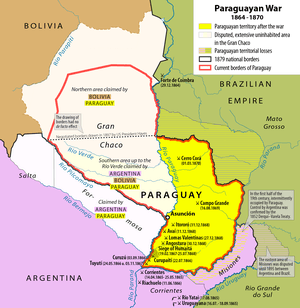
Territory disputed with Brazil
In colonial times certain lands lying to the north of the River Apa were in dispute between the Portuguese Empire and the Spanish Empire. After independence they continued to be disputed between the Empire of Brazil and the Republic of Paraguay.[107]
After the war Brazil signed a separate Loizaga – Cotegipe Treaty of peace and borders with Paraguay on 9 January 1872, in which it obtained freedom of navigation on the Paraguay River. Brazil also retained the northern regions it had claimed before the war.[108] Those regions are now part of its State of Mato Grosso do Sul.
Further details concerning the Brazil/Paraguay territorial dispute are available in the article Treaty of the Triple Alliance.
Territories disputed with Argentina
Misiones
In colonial times the missionary Jesuits established numerous villages in lands between the rivers Paraná and Uruguay. After the Jesuits were expelled from Spanish territory in 1767 the ecclesiastical authorities of both Asunción and Buenos Aires made claim to religious jurisdiction in these lands and the Spanish government sometimes awarded it to one side, sometimes to the other; sometimes they split the difference. After independence the Republic of Paraguay and the Argentine Confederation succeeded to these disputes, the details of which are complex, and are summarised in e.g. Professor Whigham's The Paraguayan War. [109] On 19 July 1852 the governments of the Argentine Confederation and Paraguay signed a treaty, by which Paraguay relinquished its claim to the Misiones.[110] However, this treaty did not become binding, because it required to be ratified by the Argentine Congress, which refused.[111] Hence Paraguay's claim was still alive on the eve of the war.
After the war the disputed lands definitively became the Argentine national territory of Misiones, now Misiones Province.
In the Gran Chaco
The Gran Chaco is an area lying to the west of the River Paraguay. Before the war it was "an enormous plain covered by swamps, chaparral and thorn forests ... home to many groups of feared Indians, including the Guaicurú, Toba and Mocobí".[111] There had long been overlapping claims to all or parts of this area by the Argentine Confederation, Bolivia and Paraguay. With some exceptions, these were paper claims, because none of those countries was in effective occupation of the area: essentially they were claims to be the true successor to the Spanish Empire, in an area never effectively occupied by Spain itself, and wherein Spain had no particular motive for prescribing internal boundaries.
The exceptions were as follows. First, in order to defend itself against Indian incursions, both in colonial times and after, the authorities in Asunción (Paraguay) had established some border fortlets on the west bank of the river Paraguay i.e. in a coastal strip within the Chaco. By the same treaty of 19 July 1852 between Paraguay and the Argentine Confederation, an undefined area in the Chaco north of the Bermejo River was implicitly conceded to belong to Paraguay. As already stated, the Argentine Congress refused to ratify this treaty; and it was protested by the government of Bolivia as inimical to its own claims. The second exception was that in 1854 the government of Carlos Antonio López established a colony of French immigrants on the right bank of the River Paraguay at Nueva Burdeos; when it failed, it was renamed Villa Occidental.[112] (Eventually, Villa Occidental was the basis of Paraguay's successful claim to territory north of the Pilcomayo River, in the Hayes arbitration; see below.)
After 1852, and more especially after the State of Buenos Aires rejoined the Argentine Confederation, Argentina's claim to the Chaco hardened; it claimed territory all the way up to the border with Bolivia. By Article XVI[113] of the Treaty of the Triple Alliance Argentina was to receive this territory in full. However, the Brazilian government disliked what its representative in Buenos Aires had negotiated in this respect, and resolved that Argentina should not receive "a handsbreadth of territory" above the Pilcomayo River. It set out to frustrate Argentina's further claim, with eventual success.
The post-war border between Paraguay and Argentina was resolved through long negotiations, completed 3 February 1876 by signing the Machaín-Irigoyen Treaty. This treaty granted Argentina roughly 1/3 of the area it had originally desired. Argentina became the strongest of the River Plate countries.
When the two parties could not reach consensus on the fate of the Chaco Boreal area between the Río Verde and the main branch of Río Pilcomayo, US President Rutherford B. Hayes was asked to arbitrate. His award was in Paraguay's favour. The Paraguayan Presidente Hayes Department is named in his honour.
Further details are available in the article Treaty of the Triple Alliance.
Consequences of the war
Paraguay
There was destruction of the existing state, loss of neighboring territories and ruin of the Paraguayan economy, so that even decades later, it could not develop in the same way as its neighbors. Paraguay is estimated to have lost up to 69% of its population, most of them due to illness, hunger and physical exhaustion, of which 90% were male, and also maintained a high debt of war with the allied countries that, not completely paid, ended up being pardoned in 1943 by the Brazilian President Getúlio Vargas. A new pro-Brazil government was installed in Asunción in 1869, while Paraguay remained occupied by Brazilian forces until 1876, when Argentina formally recognized the independence of that country, guaranteeing its sovereignty and leaving it a buffer state between its larger neighbors.
Brazil
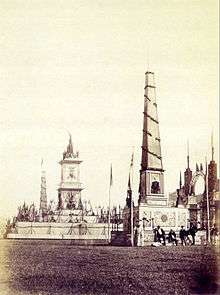
The War helped the Brazilian Empire to reach its peak of political and military influence, becoming the Great Power of South America, and also helped to bring about the end of slavery in Brazil, moving the military into a key role in the public sphere.[114] However, the war caused a ruinous increase of public debt, which took decades to pay off, severely limiting the country's growth. The war debt, alongside a long-lasting social crisis after the conflict,[115][116] are regarded as crucial factors for the fall of the Empire and proclamation of the First Brazilian Republic.[117][118]
During the war the Brazilian army took complete control of Paraguayan territory and occupied the country for six years after 1870. In part this was to prevent the annexation of even more territory by Argentina, which had wanted to seize the entire Chaco region. During this time, Brazil and Argentina had strong tensions, with the threat of armed conflict between them.
During the wartime sacking of Asunción, Brazilian soldiers carried off war trophies. Among the spoils taken was a large calibre gun called Cristiano, named because it was cast from church bells of Asunción melted down for the war.
In Brazil the war exposed the fragility of the Empire, and dissociated the monarchy from the army. The Brazilian army became a new and influential force in national life. It developed as a strong national institution that, with the war, gained tradition and internal cohesion. The Army would take a significant role in the later development of the history of the country. The economic depression and the strengthening of the army later played a large role in the deposition of the emperor Pedro II and the republican proclamation in 1889. Marshall Deodoro da Fonseca became the first Brazilian president.
As in other countries, "wartime recruitment of slaves in the Americas rarely implied a complete rejection of slavery and usually acknowledged masters' rights over their property."[119] Brazil compensated owners who freed slaves for the purpose of fighting in the war, on the condition that the freedmen immediately enlist. It also impressed slaves from owners when needing manpower, and paid compensation. In areas near the conflict, slaves took advantage of wartime conditions to escape, and some fugitive slaves volunteered for the army. Together these effects undermined the institution of slavery. But, the military also upheld owners' property rights, as it returned at least 36 fugitive slaves to owners who could satisfy its requirement for legal proof. Significantly, slavery was not officially ended until the 1880s.[119]
Brazil spent close to 614,000 réis (the Brazilian currency at the time), which were gained from the following sources:
| réis, thousands | source |
|---|---|
| 49 | Foreign loans |
| 27 | Domestic loans |
| 102 | Paper emission |
| 171 | Title emission |
| 265 | Taxes |
Due to the war, Brazil ran a deficit between 1870 and 1880, which was finally paid off. At the time foreign loans were not significant sources of funds.[120]
Argentina
Following the war, Argentina faced many federalist revolts against the national government. Economically it benefited from having sold supplies to the Brazilian army, but the war overall decreased the national treasure. The national action contributed to the consolidation of the centralized government after revolutions were put down, and the growth in influence of Army leadership.
It has been argued the conflict played a key role in the consolidation of Argentina as a nation-state.[121] That country became one of the wealthiest in the world, by the early 20th century.[122] It was the last time that Brazil and Argentina openly took such an interventionist role in Uruguay's internal politics.[123]
Uruguay
Uruguay suffered lesser effects, although nearly 5,000 soldiers were killed. As a consequence of the war, the Colorados gained political control of Uruguay and despite rebellions retained it until 1958.
Modern interpretations of the war
Interpretation of the causes of the war and its aftermath has been a controversial topic in the histories of participating countries, especially in Paraguay. There it has been considered either a fearless struggle for the rights of a smaller nation against the aggression of more powerful neighbors, or a foolish attempt to fight an unwinnable war that almost destroyed the nation.
The Great Soviet Encyclopedia, considered the official encyclopedic source of the USSR, presented a short view about the Paraguayan War, largely favourable to the Paraguayans, claiming that the conflict was a "war of imperialist aggression" long planned by slave-owners and the bourgeois capitalists, waged by Brazil, Argentina and Uruguay under instigation of Great Britain, France and United States.[124] The same encyclopedia presents Francisco Solano López as a statesman who became a great military leader and organizer, dying heroically in battle.[125]
People of Argentina have their own internal disputes over interpretations of the war: many Argentinians think the conflict was Mitre's war of conquest, and not a response to aggression. They note that Mitre used the Argentine Navy to deny access to the Río de la Plata to Brazilian ships in early 1865, thus starting the war. People in Argentina note that Solano López, mistakenly believing he would have Mitre's support, had seized the chance to attack Brazil at that time.
In December 1975, after presidents Ernesto Geisel and Alfredo Stroessner signed a treaty of friendship and co-operation[126] in Asunción, the Brazilian government returned some of its spoils of war to Paraguay, but has kept others. In April 2013 Paraguay renewed demands for the return of the "Christian" cannon. Brazil has had this on display at the former military garrison, now used as the National History Museum, and says that it is part of its history as well.[127]
Theories about British influence behind the scenes
A popular belief in Paraguay, and Argentine revisionism since the 1960s, blames the influence of the British Empire (though the academic consensus shows little or no evidence for this theory). In Brazil some have believed that the United Kingdom financed the allies against Paraguay, and that British imperialism was the catalyst for the war. The academic consensus is that no evidence supports this thesis. From 1863 to 1865 Brazil and the UK had an extended diplomatic crisis and, five months after the war started, cut off relations. In 1864 a British diplomat sent a letter to Solano López asking him to avoid hostilities in the region. There is no evidence that Britain forced the allies to attack Paraguay.[128]
Some left-wing historians of the 1960s and 1970s (most notably Eric Hobsbawn in his work "The Age of Capital: 1848–1875") claim that the Paraguayan War was caused by the pseudo-colonial influence of the British,[129][130] who needed a new source of cotton during the American Civil War (as the blockaded Southern States had been their main cotton supplier).[131] Right wing and even far-right wing historians, especially from Argentina[132][133] and Paraguay,[134] share the opinion that the British Empire had much to do with the war.
A document which supposedly supports this claim is a letter from Edward Thornton (Minister of Great Britain in the Plate Basin) to Prime minister Lord John Russell, which says:
The ignorant and barbaric people of Paraguay believe that it is under the protection of the most illustrious of the governments (...) and only with foreign intervention, or a war, they will be relieved from their error…[135]
Charles Washburn, who was the Minister of the United States to Paraguay and Argentina, also claims that Thornton represented Paraguay, months before the outbreak of the conflict, as:
... Worst than Abyssinia, and López (is) worst than King Tewodros II. The extinction (of Paraguay) as a nation will be benefit, to all the world… [136][137]
However, it was the assessment of E.N. Tate that
Whatever his dislike of Paraguay, Thornton appears to have had no wish that its quarrels with Argentina and Brazil, rapidly worsening at the time of his visit to Asunción, should develop into war. His influence in Buenos Aires seems to have been used consistently during the next few months in the interests of peace.[138]
Other historians dispute this claim of British influence, pointing out that there is no documentary evidence for it.[139][128] They note that, although the British economy and commercial interests benefited from the war, the UK government opposed it from the start. It believed that war damaged international commerce, and disapproved of the secret clauses in the Treaty of the Triple Alliance. Britain already was increasing imports of Egyptian cotton and did not need Paraguayan products.[140]
William Doria (the UK Chargé d'Affaires in Paraguay who briefly acted for Thornton) joined French and Italian diplomats in condemning Argentina's President Bartolomé Mitre's involvement in Uruguay. But when Thornton returned to the job in December 1863, he threw his full backing behind Mitre.[140]
Effects on yerba mate industry
Since colonial times, yerba mate had been a major cash crop for Paraguay. Until the war, it had generated significant revenues for the country. The war caused a sharp drop in harvesting of yerba mate in Paraguay, reportedly by as much as 95% between 1865 and 1867.[141] Soldiers from all sides used yerba mate to diminish hunger pangs and alleviate combat anxiety.[142]
Much of the 156,415 square kilometers (60,392 sq mi) lost by Paraguay to Argentina and Brazil was rich in yerba mate, so by the end of the 19th century, Brazil became the leading producer of the crop.[142] Foreign entrepreneurs entered the Paraguayan market and took control of its remaining yerba mate production and industry.[141]
Notes
- According to historian Chris Leuchars, it is known as "the War of the Triple Alliance, or the Paraguayan War, as it is more popularly termed." See Leuchars 2002, p. 33.
- Mitre systematized the exchange of correspondence with Caxias, in the previous month, about the Allied advance, in a document entitled Memoria Militar (65 pages written in Tuiu-Cuê), in which included his military plans and the planning of attack of Humaitá.[69]
References
- Burton 1870, p. 76.
- Sir Richard Francis Burton: "Letters from the Battlefields of Paraguay", p.76 – Tinsley Brothers Editors – London (1870) – Burton, as a witness of the conflict, marks this date as the real beginning of the war. He writes: "The Brazilian Army invades the Banda Oriental, despite the protestations of President López, who declared that such invasion would be held a 'casus belli'."
- "De re Militari: muertos en Guerras, Dictaduras y Genocidios". remilitari.com.
- [Bethell, Leslie, The Paraguayan War, p.1]
- Box 1967, p. 54.
- Box 1967, pp. 54–69.
- Whigham 2002, pp. 94–102.
- Box 1967, pp. 29–53.
- Whigham 2002, pp. 77–85.
- Miguel Angel Centeno, Blood and Debt: War and the Nation-State in Latin America, University Park, PA: Pennsylvania State University Press, 1957. Page 55.
- Whigham 2002, p. 118.
- Rosa 2008, p. 94.
- Thompson 1869, p. 17-19.
- Hooker, T.D., 2008, The Paraguayan War, Nottingham: Foundry Books, ISBN 1901543153
- Herrera 1943, p. 243-244.
- Scheina 2003, pp. 313–4.
- Herrera 1943, pp. 453–455.
- Pomer 2008, pp. 96–98.
- Box 1967, pp. 156–162.
- Weisiger 2013, p. 97.
- Thompson 1869, p. 20.
- Scheina 2003, p. 313.
- http://www.areamilitar.net/HISTbcr.aspx?N=144
- Bormann 1907, p. 281.
- Tasso Fragoso 2009, Vol 1, p. 254.
- Schneider 2009, p. 99.
- Needell 2006, p. 227.
- Kraay & Whigham 2004, p. 123; Schneider 2009, p. 100; Whigham 2002, p. 236
- Scheina 2003, pp. 315–7.
- Salles 2003, p. 18.
- Scheina 2003, p. 318.
- Wilson 2004, p. .
- Salles 2003, p. 38.
- Scheina 2003, p. 341.
- Thompson 1869, p. 40-45.
- Rosa 2008, p. 198.
- Scheina 2003, p. 319.
- Pomer 2008, p. 240-241.
- Scheina 2003, p. 320.
- Doratioto 2003, pp. 175–179.
- Doratioto 2003, p. 180.
- Doratioto 2003, p. 181.
- Doratioto 2003, p. 183.
- Kolinski 1965, p. 59-60.
- Kolinski 1965, p. 62.
- Amerlan 1902, p. 38.
- Doratioto 2003, p. 201.
- Leuchars 2002, p. 120-134.
- Cancogni and Boris 1972, p. 138-139.
- Leuchars 2002, p. 135.
- O'Leary 2011, p. 234.
- Doratioto 2003, pp. 234–235.
- Cancogni and Boris 1972, p. 149-150.
- Vasconsellos 1970, p. 108.
- Leuchars 2002, p. 150.
- Kolinski 1965, p. 97.
- Doratioto 2003, p. 247.
- Doratioto 2003, p. 244.
- Doratioto 2003, p. 252.
- Doratioto 2003, p. 253.
- Doratioto 2003, p. 276.
- Doratioto 2003, p. 278.
- Doratioto 2003, pp. 280–282.
- Doratioto 2003, p. 284.
- Doratioto 2003, p. 295.
- Doratioto 2003, p. 297.
- Doratioto 2003, p. 298.
- Baron of Jaceguay, "A Guerra do Paraguay", op. cit., p.134. Emilio Jourdan, cied by Augusto Tasso Fragoso, op. cit., vol. III, p. 253; and pp. 257–8.
- Enrique I. Rottjer, op. cit., p. 199
- Baron of Jaceguay, "A Guerra do Paraguay", op. cit., in baron of Jaceguay and Carlos Vidal de Oliveira, Quatro séculos de atividade marítima: Portugal e Brasil, Rio de Janeiro, Imprensa Nacional, 1900, pp. 166 and 188; Romeu Beltrão, O vanguardeiro de Itororó, Santa Maria, RS, Câmara Municipal de Vereadores, pp. 121–2
- Amerlan 1902, p. 99-102.
- Doratioto 2003, pp. 311–312.
- Doratioto 2003, p. 312.
- Kolinski 1965, p. 132.
- "Paraguay - The War of the Triple Alliance". countrystudies.us.
- Doratioto 2003, p. 318.
- Doratioto 2003, p. 355.
- Doratioto 2003, pp. 321–322.
- Whigham 2002, pp. 281–289.
- Cancogni and Boris 1972, p. 203.
- Warren, Harris Gaylord (11 November 2014). Paraguay and the Triple Alliance: The Postwar Decade, 1869-1878. University of Texas Press. ISBN 9781477306994 – via Google Books.
- Doratioto 2003, p. 420.
- Doratioto 2003, p. 426.
- Gabriele Esposito (20 March 2015). Armies of the War of the Triple Alliance 1864–70: Paraguay, Brazil, Uruguay & Argentina. Osprey Publishing. p. 19. ISBN 978-1-4728-0725-0.
- Doratioto 2003, pp. 445–446.
- Shaw 2005, p. 30.
- Bareiro, p. 90.
- Doratioto 2003, p. 451.
- see F. Chartrain : "L'Eglise et les partis dans la vie politique du Paraguay depuis l'Indépendance", Paris I University, "Doctorat d'Etat", 1972, pp. 134–135
- An early 20th-century estimate is that from a prewar population of 1,337,437, the population fell to 221,709 (28,746 men, 106,254 women, 86,079 children) by the end of the war (War and the Breed, David Starr Jordan, p. 164. Boston, 1915; Applied Genetics, Paul Popenoe, New York: Macmillan Company, 1918)
- Byron Farwell, The Encyclopedia of Nineteenth-Century Land Warfare: An Illustrated World View, New York: WW Norton, 2001. p. 824,
- See the main article Paraguayan War casualties.
- Jürg Meister, Francisco Solano López Nationalheld oder Kriegsverbrecher?, Osnabrück: Biblio Verlag, 1987. 345, 355, 454–5. ISBN 3-7648-1491-8
- Reber, Vera Blinn (May 1988). "The Demographics of Paraguay: A Reinterpretation of the Great War, 1865–1870". Hispanic American Historical Review (Duke University Press) 68: 289–319.
- "Holocausto paraguayo en Guerra del '70". abc. Archived from the original on 22 May 2011. Retrieved 26 October 2009.
- Pinker, Steven (2011). Better Angels of Our Nature: Why Violence Has Declined. London: Penguin. ISBN 978-0-14-312201-2. Steven Pinker
- Ganson, Barbara J. (January 1990). "Following Their Children into Battle: Women at War in Paraguay, 1864–1870". The Americas, 46, 3. Retrieved 18 April 2007, from JSTOR database.
- Chasteen, John Charles. (2006). Born in Blood & Fire: A Concise History of Latin America. New York: W.W. Norton & Company.
- "The never-ending war". The Economist. 22 December 2012. ISSN 0013-0613. Retrieved 27 January 2020.
- Kraay, Hendrik (2004). I Die with My Country: Perspectives on the Paraguayan War, 1864–1870. Lincoln: University of Nebraska Press. p. 182.
- Masterman, George Frederick (1870). Seven Eventful Years in Paraguay, A Narrative of Personal Experience Amongst the Paraguayans. London: Sampson Low, Son and Marston. p. 133.
- Washburn, Charles (1871). The History of Paraguay, with notes of personal observations, and reminiscences of diplomacy under difficulties. Boston: Lee & Shepherd. p. 29.
- Taunay, Alfredo d’Escragnolle Taunay, Visconde de (1871). La retraite de Laguna. Rio de Janeiro. p. 67.
- Kraay, Hendrik (2004). I Die with My Country: Perspectives on the Paraguayan War, 1864–1870. Lincoln: University of Nebraska Press. p. 66.
- Whigham, Thomas L. (2002). Paraguayan War: Volume 1: Causes and Early Conduct. Lincoln: University of Nebraska Press. p. 170.
- Ipsen, Wiebke (2012). "Patricias, Patriarchy, and Popular Demobilization: Gender and Elite Hegemony in Brazil at the End of the Paraguayan War". Hispanic American Historical Review. 92: 312. doi:10.1215/00182168-1545701.
- Williams 1980, pp. 17–40.
- Vasconsellos 1970, pp. 78, 110–114.
- Whigham 2002, pp. 93–109.
- Whigham 2002, pp. 108.
- Whigham 2002, p. 109.
- Whigham 2002, pp. 109–113.
- Second indent.
- Francisco Doriatoto, Maldita guerra: nova história da Guerra do Paraguai. Companhia das Letras. ISBN 978-85-359-0224-2. 2003
- Amaro Cavalcanti, Resenha financeira do ex-imperio do Brazil em 1889, Imprensa Nacional, Río de Janeiro. 1890
- Alfredo Boccia Romanach, Paraguay y Brasil: Crónica de sus Conflictos, Editorial El Lector, Asunción. 2000
- Rex A. Hudson, Brazil: A Country Study. Washington: GPO for the Library of Congress, 1997
- José Murilo de Carvalho, D. Pedro II: ser ou não ser (in Portuguese). São Paulo: Companhia das Letras. 2007
- Kraay, Hendrik (1996). "'The Shelter of the Uniform': The Brazilian Army and Runaway Slaves, 1800–1888". Journal of Social History. 29 (3): 637–657. doi:10.1353/jsh/29.3.637. JSTOR 3788949.
- DORATIOTO, Francisco, Maldita Guerra, Companhia das Letras, 2002
- Historia de las relaciones exteriores de la República Argentina (notes from CEMA University, in Spanish, and references therein)
- Historical Statistics of the World Economy: 1–2008 AD by Angus Maddison
- Scheina 2003, p. 331.
- Paraguayan War. (n.d.) The Great Soviet Encyclopedia, 3rd Edition. (1970-1979). Retrieved October 12, 2018 from https://encyclopedia2.thefreedictionary.com/Paraguayan+War
- francisco solano lopez. (n.d.) The Great Soviet Encyclopedia, 3rd Edition. (1970-1979). Retrieved October 12, 2018 from https://encyclopedia2.thefreedictionary.com/Francisco+Solano+Lopez
- "Treaty of friendship and co-operation 4 December 1975" (PDF). Retrieved 10 May 2013.
- Isabel Fleck, "Paraguai exige do Brasil a volta do "Cristão", trazido como troféu de guerra" (Paraguay has demanded Brazil return the "Christian", taken as a war trophy), Folha de S. Paulo, 18 April 2013. Retrieved 1 July 2013
- Kraay, Hendrik; Whigham, Thomas L. (2004). "I die with my country:" Perspectives on the Paraguayan War, 1864–1870. Dexter, Michigan: Thomson-Shore. ISBN 978-0-8032-2762-0, p. 16 Quote: "During the 1960s, revisionists influenced by both left-wing dependency theory and, paradoxically, an older, right-wing nationalism (especially in Argentina) focused on Britain’s role in the region. They saw the war as a plot hatched in London to open up a supposedly wealthy Paraguay to the international economy. With more enthusiasm than evidence revisionists presented the loans contracted in London by Argentina, Uruguay, and Brazil as proof of the insidious role of foreign capital. Little evidence for these allegations about Britain’s role has emerged, and the one serious study to analyze this question has found nothing in the documentary base to confirm the revisionist claim."
- Galeano, Eduardo. "Open Veins of Latin America: Five Centuries of the Pillage of a Continent," Monthly Review Press, 1997
- Chiavenatto,Julio José. Genocídio Americano: A Guerra do Paraguai, Editora Brasiliense, SP. Brasil, 1979
- Historia General de las relaciones internacionales de la República Argentina (in Spanish)
- Rosa, José María. "La Guerra del Paraguay y las Montoneras Argentinas". Editorial Punto de Encuentro, Buenos Aires, 2011
- Mellid, Atilio García. "Proceso a los Falsificadores de la Historia del Paraguay", Ediciones Theoria, Buenos Aires, 1959
- González, Natalicio. "La guerra del Paraguay: imperialismo y nacionalismo en el Río de la Plata". Editorial Sudestada, Buenos Aires, 1968
- Rosa 2008, p. 142-143.
- Washburn 1871, p. 544.
- Pomer 2008, p. 56.
- Tate 1979, p. 59.
- Salles 2003, p. 14.
- Historia General de las relaciones internacionales de la República Argentina(in Spanish)
- Blinn Reber, Vera. Yerba Mate in Nineteenth Century Paraguay, 1985.
- Folch, Christine (2010). "Stimulating Consumption: Yerba Mate Myths, Markets, and Meanings from Conquest to Present". Comparative Studies in Society and History. 52 (1): 6–36. doi:10.1017/S0010417509990314.
Bibliography
| Library resources about Paraguayan War |
- Abente, Diego (1987). "The War of the Triple Alliance". Latin American Research Review. 22 (2): 47–69.CS1 maint: ref=harv (link)
- Amerlan, Albert (1902). Nights on the Río Paraguay: Scenes on the Paraguayan War and Charactersketches. Buenos Aires: Herman Tjarks and Co.CS1 maint: ref=harv (link)
- Bormann, José Bernardino (1907). A Campanha do Uruguay (1864–65) (in Portuguese). Rio de Janeiro: Imprensa Nacional.CS1 maint: ref=harv (link)
- Box, Pelham Horton (1967). The origins of the Paraguayan War. New York: Russel & Russel.CS1 maint: ref=harv (link)
- Burton, Richard Francis (1870). Letters from the Battlefields of Paraguay. London: Tinsley Brothers.CS1 maint: ref=harv (link)
- Cancogni and Boris (1972). Il Napoleone del Plata (The Napoleon of the Plate) (in Italian). Milano: Rizzoli Editores.CS1 maint: ref=harv (link)
- Cunninghame Graham, Robert Bontine (1933). Portrait of a Dictator: Francisco Solano López. London: William Heinemann Ltd.CS1 maint: ref=harv (link)
- Davis, William H. (1977). "Question 1/77". Warship International. XIV (2): 161–172. ISSN 0043-0374.
- Doratioto, Francisco (2003). Maldita guerra: nova história da Guerra do Paraguai. Companhia das Letras. ISBN 978-85-359-0224-2. Retrieved 19 June 2015.CS1 maint: ref=harv (link)
- Ehlers, Hartmut (2004). "The Paraguayan Navy: Past and Present". Warship International. XLI (1): 79–97. ISSN 0043-0374.
- Ehlers, Hartmut (2004). "The Paraguayan Navy: Past and Present, Part II". Warship International. XLI (2): 173–206. ISSN 0043-0374.
- Gratz, George A. (1998). "Question 1/77: Warships of the War of the Triple Alliance". Warship International. XXXV (2): 210–211. ISSN 0043-0374.
- Hardy, Osgood (October 1919). "South American Alliances: Some Political and Geographical Considerations". Geographical Review. 8 (4/5): 259–265. doi:10.2307/207840. JSTOR 207840.CS1 maint: ref=harv (link)
- Herrera, Luis Alberto (1943). El Drama del 65: La Culpa Mitrista. Buenos Aires - Montevideo: Edición Homenaje.CS1 maint: ref=harv (link)
- Hooker, Terry D. (2008). The Paraguayan War. Nottingham: Foundry Books. ISBN 978-1-901543-15-5.CS1 maint: ref=harv (link)
- JACEGUAY, "A Guerra do Paraguay: reflexões críticas sobre as operações combinadas da esquadra brasileira e exércitos aliados". In, JACEGUAY, baron de & OLIVEIRA DE FREITAS, Carlos Vidal. Quatro séculos de atividade marítima: Portugal e Brasil. Imprensa Nacional, 1900
- Kolinski, Charles J. (1965). Independence or Death! The story of the Paraguayan War. Gainesville, Florida: University of Florida Press.CS1 maint: ref=harv (link)
- Kraay, Hendrik; Whigham, Thomas L. (2004). I Die with My Country: Perspectives on the Paraguayan War, 1864–1870. Dexter, Michigan: Thomson-Shore. ISBN 978-0-8032-2762-0.CS1 maint: ref=harv (link)
- Leuchars, Chris (2002). To the Bitter End: Paraguay and the War of the Triple Alliance. Westport, Connecticut: Greenwood Press. ISBN 0-313-32365-8.CS1 maint: ref=harv (link)
- Marley, David (1998). Wars of the Americas. Santa Barbara: ABC-CLIO. ISBN 0-87436-837-5.CS1 maint: ref=harv (link)
- Mellid, Atilio García (1959). Proceso a los Falsificadores de la Historia del Paraguay (2 vols.) (in Spanish). Buenos Aires: Ediciones Theoría.CS1 maint: ref=harv (link)
- Nabuco, Joaquim (1901). La Guerra del Paraguay (in Spanish). Buenos Aires: Ediciones Garnier.CS1 maint: ref=harv (link)
- Needell, Jeffrey D. (2006). The Party of Order: the Conservatives, the State, and Slavery in the Brazilian Monarchy, 1831–1871. Stanford, California: Stanford University Press. ISBN 978-0-8047-5369-2.CS1 maint: ref=harv (link)
- O'Leary, Juan (2011). Recuerdos de Gloria: Artículos Históricos sobre la Guerra de la Triple Alianza (in Spanish). Asunción: Servilibro.CS1 maint: ref=harv (link)
- Peñalba, José Alfredo Fornos (April 1982). "Draft Dodgers, War Resisters and Turbulent Gauchos: The War of the Triple Alliance against Paraguay". The Americas. 38 (4): 463–479. doi:10.2307/981208. JSTOR 981208.CS1 maint: ref=harv (link)
- Pomer, León (2008). La Guerra del Paraguay: Estado, Política y Negocios (in Spanish). Buenos Aires: Editorial Colihue.CS1 maint: ref=harv (link)
- Rosa, José María (2008). La Guerra del Paraguay y las Montoneras Argentinas (in Spanish). Buenos Aires: Editorial Punto de Encuentro.CS1 maint: ref=harv (link)
- Salles, Ricardo (2003). Guerra do Paraguai: Memórias & Imagens (in Portuguese). Rio de Janeiro: Bibilioteca Nacional.CS1 maint: ref=harv (link)
- Scheina, Robert (2003). Latin America's Wars: The Age of the Caudillo, 1791–1899. Dulles, Virginia: Brassey's.CS1 maint: ref=harv (link)
- Schneider, Louis (2009). A Guerra da Tríplice Aliança Contra o Paraguai (in Portuguese). Porto Alegre: Pradense. ISBN 978-85-89072-13-7.CS1 maint: ref=harv (link)
- Shaw, Karl (2005) [2004]. Power Mad! [Šílenství mocných] (in Czech). Praha: Metafora. ISBN 978-80-7359-002-4.CS1 maint: ref=harv (link)
- Tasso Fragoso, Augusto (2009). História da Guerra entre a Tríplice Aliança e o Paraguai (in Portuguese). 1 (3 ed.). Rio de Janeiro: Biblioteca do Exército.
- Tate, E. N. (1979). "Britain and Latin America in the Nineteenth Century: The Case of Paraguay". Ibero-amerikanisches Archiv, Neue Folge. 5 (1): 39–70.CS1 maint: ref=harv (link)
- Thompson, George (1869). The War in Paraguay: With a historical sketch of the country and its people and notes upon the military engineering of the war. London, England: Longmans and Green Co.CS1 maint: ref=harv (link)
- Vasconsellos, Victor N. (1970). Resumen de Historia del Paraguay. Delimitaciones Territoriales. Asunción, Paraguay: Industria Grafica Comuneros.CS1 maint: ref=harv (link)
- Washburn, Charles (1871). The history of Paraguay : with notes of personal observations, and reminiscences of diplomacy under difficulties (2 vols). Lincoln, Nebraska: University of Nebraska Press.CS1 maint: ref=harv (link)
- Weisiger, Alex (2013). Logics of War: Explanations for Limited and Unlimited Conflicts. Ithaca, New York: Cornell University Press. p. 97. ISBN 9780801468162.
Paraguay Brazil ultimatum.
CS1 maint: ref=harv (link) - Whigham, Thomas L. (2002). The Paraguayan War: Causes and Early Conduct. 1. Lincoln, Nebraska: University of Nebraska Press. ISBN 978-0-8032-4786-4.CS1 maint: ref=harv (link)
- Whigham, Thomas L. 2017. The Road to Armageddon: Paraguay versus the Triple Alliance, 1866–70. Calgary, AB: University of Calgary Press.
- Williams, John Hoyt (1980). "The Undrawn Line: Three Centuries of Strife on the Paraguayan-Mato Grosso Frontier". Luso-Brazilian Review. University of Wisconsin Press. 17 (1): 17–40. JSTOR 3513374.CS1 maint: ref=harv (link)
- Williams, John Hoyt (April 2000). "The Battle of Tuyuti". Military History. 17 (1): 58.CS1 maint: ref=harv (link)
- Wilson, Peter (May 2004). "Latin America's Total War". History Today. 54 (5). ISSN 0018-2753.CS1 maint: ref=harv (link)

External links

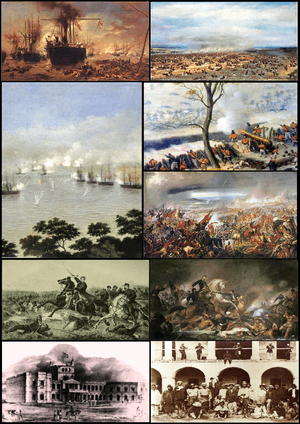

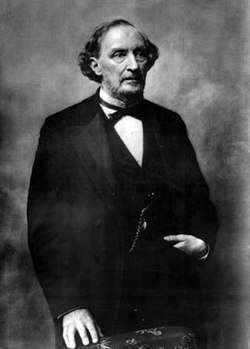

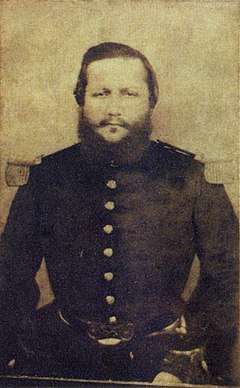

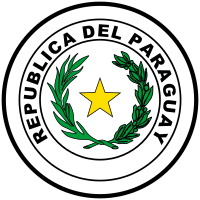
.svg.png)
